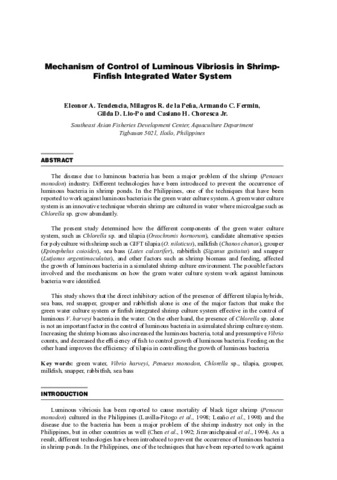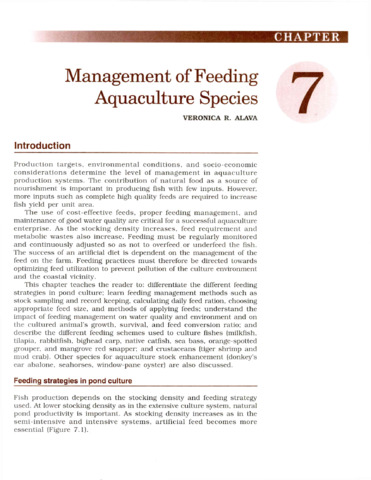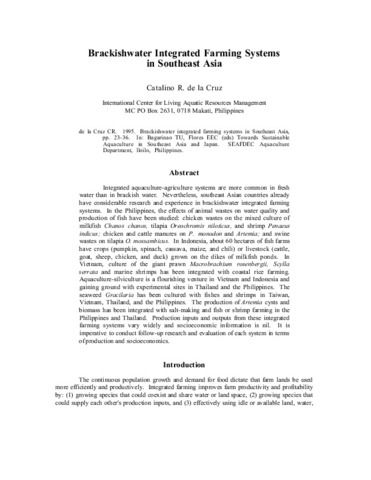Mechanism of control of luminous vibriosis in shrimp-finfish integrated water system
| dc.contributor.author | Tendencia, Eleonor | |
| dc.contributor.author | de la Peña, Milagros R. | |
| dc.contributor.author | Fermin, Armando C. | |
| dc.contributor.author | Lio-Po, Gilda D. | |
| dc.contributor.author | Choresca Jr., Casiano H. | |
| dc.contributor.editor | Nagasawa, Kazuya | |
| dc.date.accessioned | 2020-07-22T02:25:51Z | |
| dc.date.available | 2020-07-22T02:25:51Z | |
| dc.date.issued | 2005-03 | |
| dc.identifier.citation | Tendencia, E. A., de la Peña, M. R., Fermin, A. C., Lio-Po, G. D., & Choresca, Jr., C. H. (2005). Mechanism of control of luminous vibriosis in shrimp-finfish integrated water system. In K. Nagasawa (Ed.), Recent Advances in Diagnosis and Prevention of Fish and Shrimp Diseases in Southeast Asia (pp. 197–221). Tigbauan, Iloilo, Philippines: Aquaculture Department, Southeast Asian Fisheries Development Center. | en |
| dc.identifier.isbn | 9718511732 | |
| dc.identifier.uri | http://hdl.handle.net/10862/5927 | |
| dc.description.abstract | The disease due to luminous bacteria has been a major problem of the shrimp (Penaues monodon) industry. Different technologies have been introduced to prevent the occurrence of luminous bacteria in shrimp ponds. In the Philippines, one of the techniques that have been reported to work against luminous bacteria is the green water culture system. A green water culture system is an innovative technique wherein shrimp are cultured in water where microalgae such as Chlorella sp. grow abundantly. The present study determined how the different components of the green water culture system, such as Chlorella sp. and tilapia (Oreochromis hornorum), candidate alternative species for polyculture with shrimp such as GIFT tilapia (O. niloticus), milkfish (Chanos chanos), grouper (Epinephelus coioides), sea bass (Lates calcarifer), rabbitfish (Siganus guttatus) and snapper (Lutjanus argentimaculatus), and other factors such as shrimp biomass and feeding, affected the growth of luminous bacteria in a simulated shrimp culture environment. The possible factors involved and the mechanisms on how the green water culture system work against luminous bacteria were identified. This study shows that the direct inhibitory action of the presence of different tilapia hybrids, sea bass, red snapper, grouper and rabbitfish alone is one of the major factors that make the green water culture system or finfish integrated shrimp culture system effective in the control of luminous V. harveyi bacteria in the water. On the other hand, the presence of Chlorella sp. alone is not an important factor in the control of luminous bacteria in a simulated shrimp culture system. Increasing the shrimp biomass also increased the luminous bacteria, total and presumptive Vibrio counts, and decreased the efficiency of fish to control growth of luminous bacteria. Feeding on the other hand improves the efficiency of tilapia in controlling the growth of luminous bacteria. | en |
| dc.language.iso | en | en |
| dc.publisher | Aquaculture Department, Southeast Asian Fisheries Development Center | en |
| dc.subject | Penaeus monodon | en |
| dc.subject | Chlorella | en |
| dc.subject | tilapia | en |
| dc.subject | Oreochromis niloticus | en |
| dc.subject | milkfish | en |
| dc.subject | Chanos chanos | en |
| dc.subject | groupers | en |
| dc.subject | Epinephelus coioides | en |
| dc.subject | sea bass | en |
| dc.subject | Lates calcarifer | en |
| dc.subject | Siganus guttatus | en |
| dc.subject | snappers | en |
| dc.subject | Lutjanus argentimaculatus | en |
| dc.title | Mechanism of control of luminous vibriosis in shrimp-finfish integrated water system | en |
| dc.type | Book chapter | en |
| dc.citation.spage | 197 | |
| dc.citation.epage | 221 | |
| dc.citation.bookTitle | Recent Advances in Diagnosis and Prevention of Fish and Shrimp Diseases in Southeast Asia | en |
| dc.subject.asfa | animal diseases | en |
| dc.subject.asfa | shrimp culture | en |
| dc.subject.asfa | chlorophylls | en |
| dc.subject.asfa | fecundity | en |
| dc.subject.asfa | antibiotics | en |
| dc.subject.asfa | polyculture (aquaculture) | en |
| dc.subject.asfa | fish culture | en |
| dc.subject.asfa | aquaculture | en |
| dc.subject.asfa | milkfish culture | en |
| dc.subject.asfa | tilapia culture | en |
| dc.subject.asfa | water samples | en |
| dc.subject.asfa | biomass | en |
| dc.subject.asfa | feeding | en |
| dc.subject.asfa | sampling | en |
| dc.subject.asfa | statistical analysis | en |
| dc.subject.scientificName | Penaeus monodon | en |
| dc.subject.scientificName | Vibrio harveyi | en |
| dc.subject.scientificName | Chanos chanos | |
| dc.subject.scientificName | Lates calcarifer | en |
Files in this item
This item appears in the following Collection(s)
-
Recent Advances in Diagnosis and Prevention of Fish and Shrimp Diseases in Southeast Asia [43]
Terminal Report of the Regional Fish Disease Project on “Development of Fish Disease Inspection Methodologies for Artificially-Bred Seeds” Funded by the Government of Japan Trust Fund from 2000 to 2004


 AQD Access only
AQD Access only


